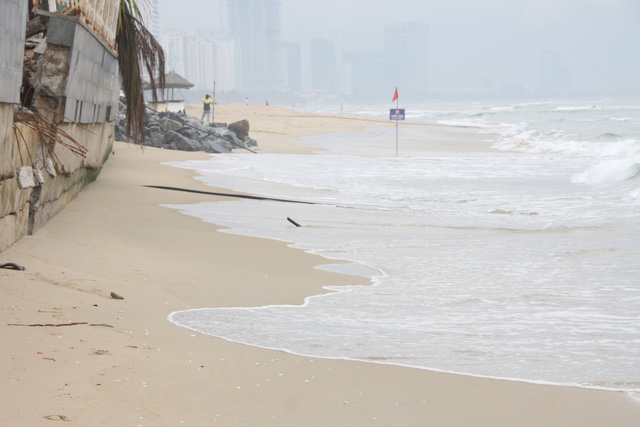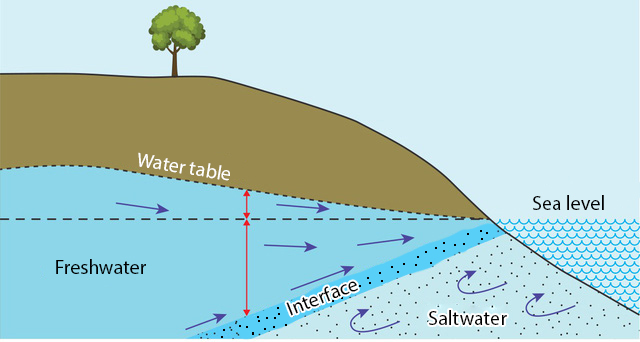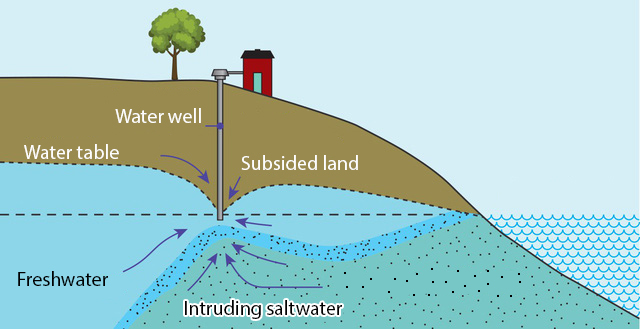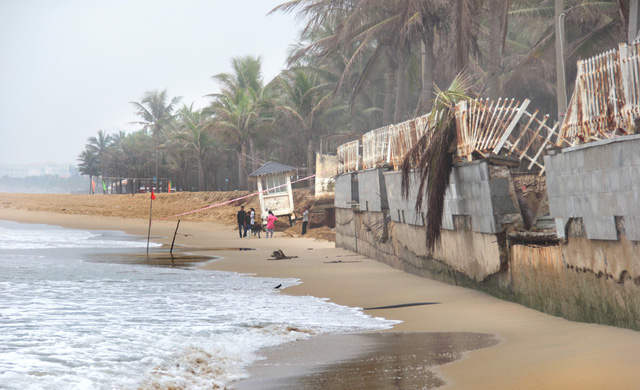Severe coastal erosion and land subsidence are posing an immediate threat to the world-famous My Khe beach in the resort city of Da Nang in central Vietnam, with experts blaming overexploitation of groundwater along the coast.
Areas along the ten-kilometer My Khe beach have become badly eroded, with the sea encroaching on what was once a broad, sandy beach by up to 15 meters, damaging construction and buildings that sit close to the water’s edge.
Just five kilometers from the center of Da Nang, My Khe was voted among the six most beautiful beaches on the planet by American business magazine Forbes in 2013, thanks to its azure skies, smooth white sands, elegant slopes, as well as year-round warm water and gentle waves.
These natural assets may soon be a thing of the past as erosion and sea encroachment continue to take their toll on what is a tropical paradise.
“Our restaurant used to look onto a wide, sandy beach that stretched a dozen meters or more from the water’s edge. We used to be able to hold beach parties and weddings for our customers,” said Vo Thuy Tien, manager of a seaside restaurant on Vo Nguyen Giap Street.
“That beach no longer exists. Now the waves come so close to our restaurant that they have worn away the building’s foundation and damaged the electronics,” Tien added.
She said they had been forced to use large rocks to fortify the area’s foundation, but it had not stopped water from encroaching up to 15 meters inland since late 2016.
The most severely affected area is the junction between Vo Nguyen Giap and Phan Tu Streets, where an entire stretch of 200 meters worth of coastline has been washed away by waves.
The area has been made temporarily off-limits to both locals and tourists, following a swimming ban on Friday last week that was issued after a municipal inspectorate led by Da Nang chairman Huynh Duc Tho conducted a field survey of the area.
 |
| Warning signs are placed along the My Khe beach in Da Nang. Photo: Tuoi Tre |
Groundwater exploitation the primary suspect
Dr. Nguyen Thi Minh Phuong, from Da Nang-based Duy Tan University, told Tuoi Tre (Youth) newspaper that inland encroachment by the sea at My Khe is not a seasonal phenomenon but a “very real threat” caused by human activity.
According to a study conducted by the environment and chemical engineering expert’s research team, the locations of erosion-prone areas in Da Nang coincide completely with areas where there are groundwater extraction activities by high-rise constructions along the coastline.
According to the team’s findings, thousands of cubic meters of groundwater is extracted every 24 hours by these buildings, weakening the land's foundation in the area and making it susceptible to erosion by wave activity and ocean currents.
However, it is not just now that experts are warning of the danger posed to Da Nang’s groundwater resource by such construction projects.
In 2015, a local water company made public shocking statistics that over 20 high-end hotels in Da Nang used the same amount of tap water as a regular domestic household, meaning their primary source of water came from underground.
In Vietnam, the extraction and use of groundwater is neither taxed nor charged, as opposed to tap water which comes with a price tag.
According to Dr. Phuong, the consequences of groundwater exhaustion are grave, as it not only gives rise to coastal erosion, but also leads to saltwater intrusion into subsurface aquifers previously occupied by fresh water.
“For every meter of freshwater we lose above sea level, 40 meters of saltwater can intrude into the aquifer below sea level. This phenomenon is already happening, according to our findings,” Phuong explained.
“Nature always has its way of returning to a state of equilibrium, so chances are that erosion and subsidence will continue until a new equilibrium is reached,” she added.
 |
 |
| An infographic illustrating how groundwater can lead to saltwater intrusion in coastal areas. Graphic: Tuoi Tre |
Like us on Facebook or follow us on Twitter to get the latest news about Vietnam!





















































